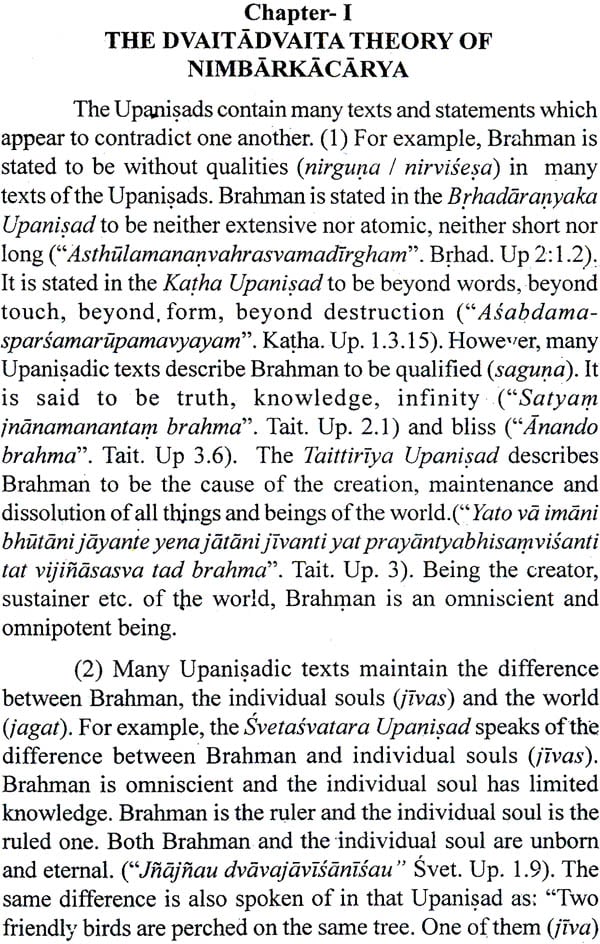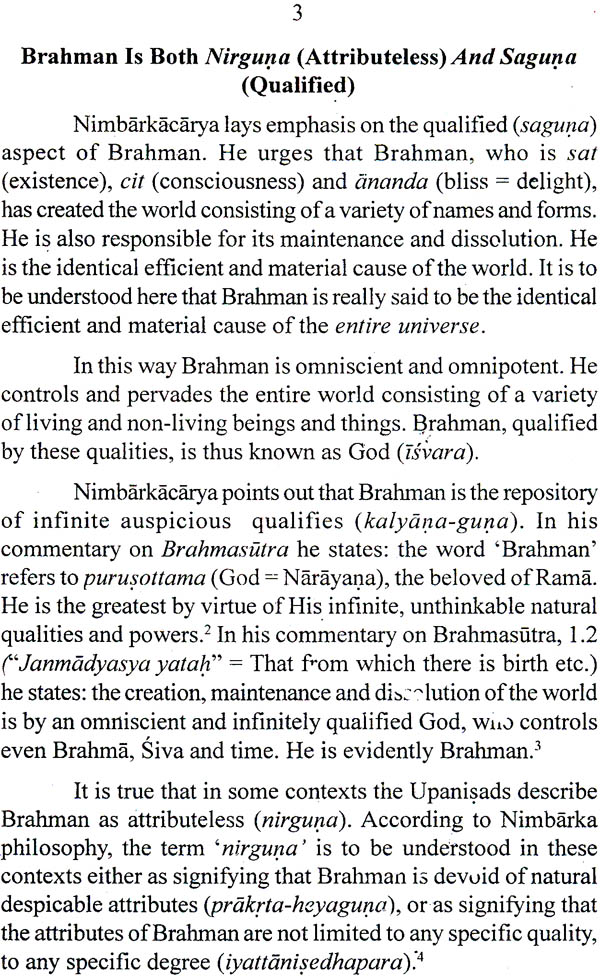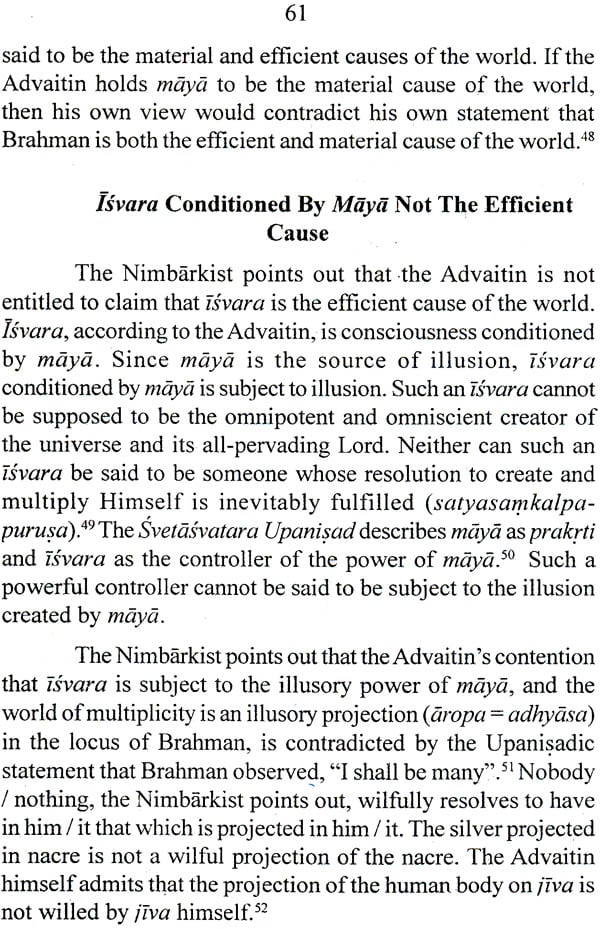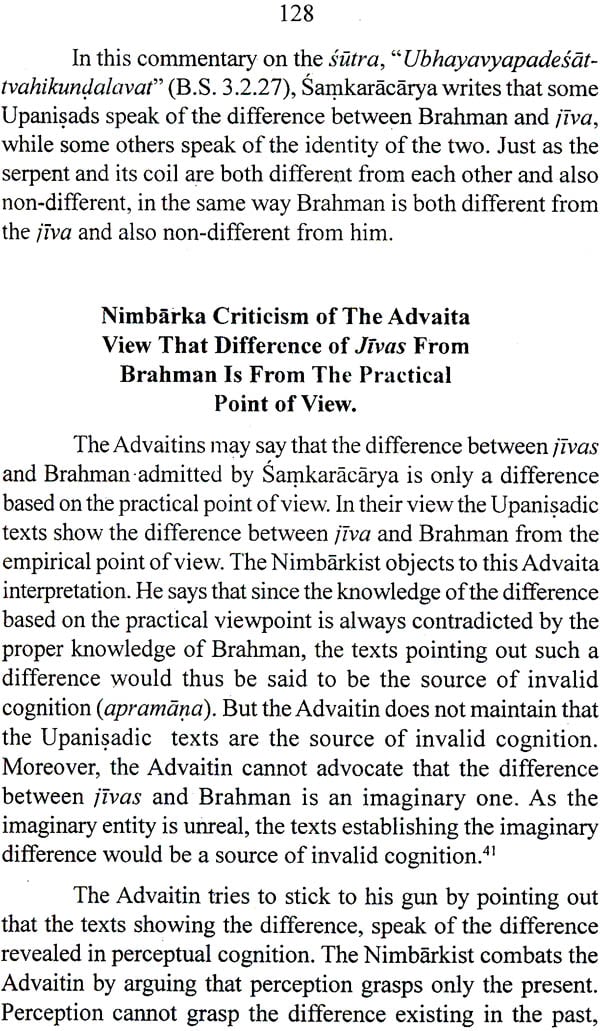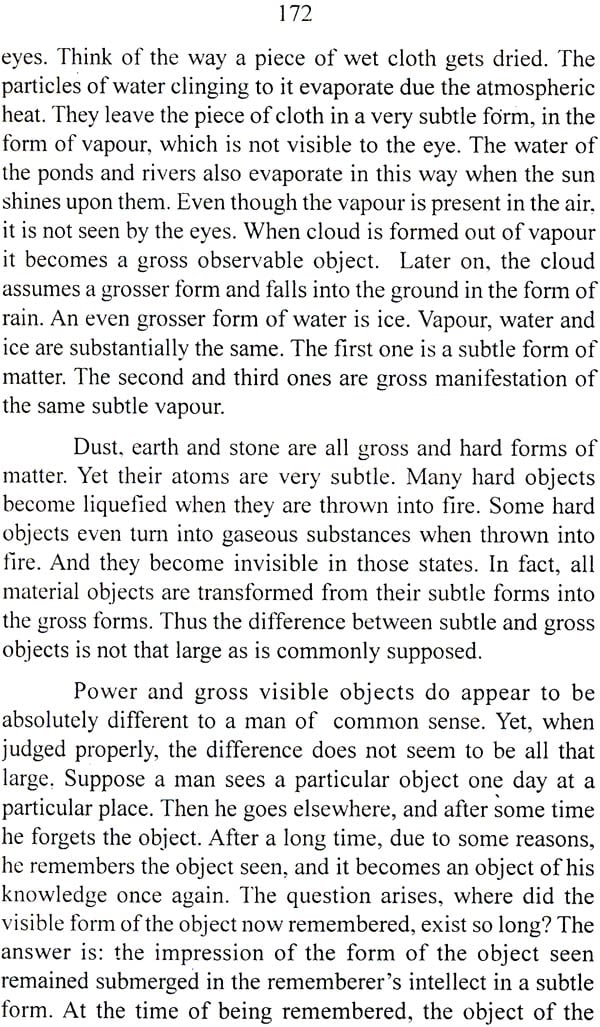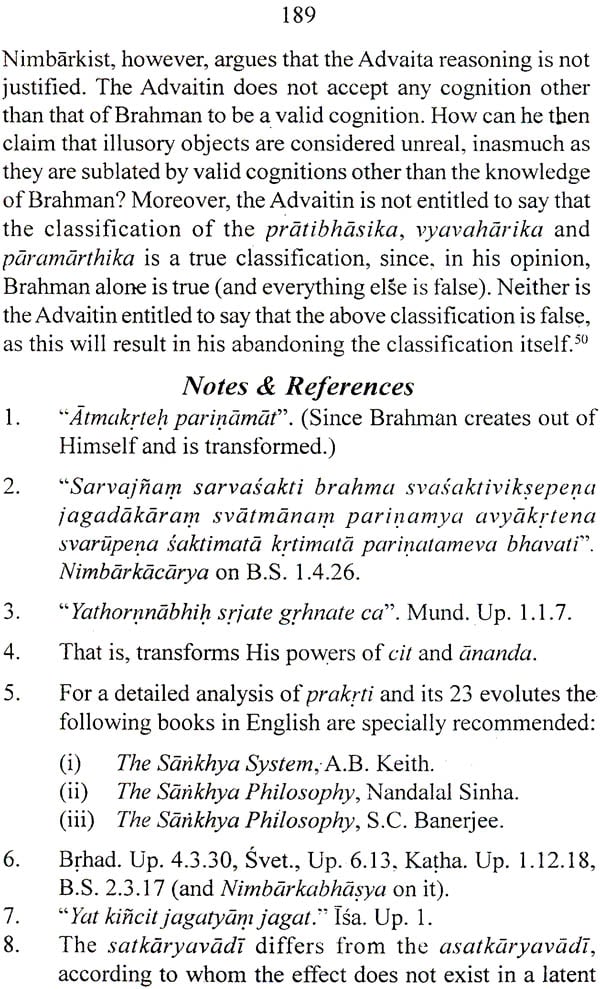
Brahman, Individual Souls and the World in Nimbarka Philosophy
Book Specification
| Item Code: | NAD044 |
| Author: | Rita Gupta |
| Publisher: | SUKHCHAR KATHIYA BABA ASHRAM |
| Edition: | 2011 |
| Pages: | 257 |
| Cover: | Hardcover |
| Other Details | 8.5 Inch X 5.5 Inch |
| Weight | 330 gm |
Book Description
I start this publisher’s note by congratulating Ms. Rita Gupta for completing this commendable job of writing a critical analysis and discussion on Brahman Tatwa that is the nature of God, Jeeva that is the nature of life forms, and Jagat Tatwa that is the nature of the universe and their relationship among each other in the context of Dwaita-Adwaitabada or dualism and non-dualism philosophy of Sri Nimbarka Dev.
She aptly points out that the Nimbarka doctrine of Dwaita-Adwaitabada offers an irrefutable perspective to scholars debating about the nature of God and his creations and this universe among themselves. Her thoughts are very well organized and her writing is easy to follow even for readers new to Nimbarka philosophy.
This Book will serve as an invaluable source of knowledge for devotees and scholars interested in Nimbarka philosophy throughout the world. This English version containing the message and philosophy of Nimbarka Dev will circulate throughout India and the world crossing the regional language barriers.
I am certain that the readers will gain much knowledge and wisdom about Nimbarka Philosophy and how it answers the eternal questions about God, life and the universe. I am delighted to get the opportunity to publish this book and to present it to the world.
I feel immensely delighted to write a foreword to the book "Brahman, Individual Souls and the World in Nimbarka philosophy" by Rita Gupta presented in lucid English with copious references and annotations.
Unfortunate, yet true is the fact that Swami Nimbarka and his siddhanta is less known in the south, since majority of works on Nimbarka's siddhanta are available only in the Bengali Language. The author's attempt in publishing this volume namely "Brahman, Individual soul and the world in Nimbarka Philosophy" in English is a splendid one which would benefit all those interested in the south as well to gain perspective in the Northern school of Vaisnavism.
The author has clearly shown that Brahman is the cause of the Universe, transforming itself into the world of matter and spirit. Like a spider which spins its web out of itself, the Brahman splits itself up into innumerable parts of spirit and matter. Still the Brahman retains its fullness and purity. This is thus Bheda and Abheda.
Regarding Jiva, the author has pointed out that Jiva is knowledge by nature and states that the atomic Jivas can cognise the various sensations in various parts of the body through all-pervasive knowledge which exists in them as their attribute.
Again, the Acit Jagat is the effect of Brahman and abides in the Brahman. The Jagat which is in the nature of a modi- fication, of the Lord's power of Prakrti is concordant with all the Srutis.
The author has done yeoman service by introducing Swami Nimbarka's siddhanta to the people all over through this scholarly treatise.
Vedanta Philosophy is a common name for the types of philosophy advocated by different schools of thought in India. Samkaracarya’s Vedanta philosophy known as Advaita Vedanta is the culmination of a certain monistic interpretation of Upanisads, Brahmasutra of Badarayana and Bhagavadgita. However the Vaisnava sects of India interpreted the Upanisads Brahmasutra and Bhagavadgita in a way quite different from that done by Samkaracarya. These interpretations culminate also in different sorts of Vedanta. They are Dvaitadvaita Vedanta of Nimbarkacarya Visistadvaita Vedanta of Ramanujacarya Dvaita Vedanta of Madhvacarya and Suddhadvaita Vedanta of Vallabhacarya.
All the different Vaisnava Schools of Vedanta emphasize the bhakti (devotion) is the best means of the direct intuitionof Brahman and consequently of Moksa (Liberation). The Dvaitadvaita School of Nimbarkacarya accordingly insists that Brahman who takes the form of all living beings and the world but is also beyond all forms who is beyond the natural qualities but yet sustains the natural world can be attained through bhakti.
The path that the Nimbarka school recommends for attaining Brahman is known as the path of bhakti. Thinking of oneself jagat (world) as forms of Brahman is an essential element of the path of bhakti. One who travels along the path of knowledge like the Advaitin only thinks of himself as indentical with Brahman. In his vision the rest of the world is different from Brahman. One who treads the path of bhakti however thinks that he himself all the jivas and the whole visible jagat are identical with Brahman.
The spiritual endeavor of one who treads the path of bhakti consist of three stages. One of the three stages is marked by the contemplation of the identity of jagat with Brahman. The other stage is marked by the contemplation of all jivas (including oneself) as identical with Brahman. The third stage comprises the meditation on Brahman who is also conceived as being over and above jiva and jagat as omniscient and full of infinite bliss. The first two stages of spiritual contemplation fully purify the mind of the devotee. The third stage is the one by which the devotee attains the direct intuition of Brahman.
According to the Nimbarkist who follows the path of bhakti, Brahman is both saguna (qualified) and nirguna. Jiva and jagat are the qualities of Brahman in the form of his powers of consciousness and ananda. Thus Brahman is saguna qalities cannot exist apart from the gunavana the substratum of qualities. Hence jiva and jagat are abhima with the gunavana, Brahman yet as the substratum of qualities Brahman exists over and above the qualities jiva and jagat. Hence Brahman is not fully identical with his qualities jiva and jagat in this sense Brahman is nirguna beyond the qualities.
Towards the end of his spiritual journey the devotee realizes both the identity of Jiva and jagat with Brahman and also the fact that Brahman in his essence transcends jiva and jagat. This realization produces parabhakti (supreme devotion). This Parabhakti which enables the devotee to see everything as Brahman leads the devotee towards the cidanandamaya highest existence. This realization is possible not through the path of knowledge but only through that of bhakti. And this realization enables the devotee to attain liberation and thereby enjoy limitless happiness and bliss by attaining anandamaya Brahman. However the Nimbarkist contends that proper liberation is possible only when the devotee who has directly intuited Brahman enters Brahmaloka after dissociating himself from his body. This liberation is accordingly called videhamukti (disembodied liberation).
The Nimbarkist maintains that even in the state of videhamukti the liberated jiva only enjoys similarity with Brahman. He does not become completely identical with Brahman. Even in the state of videhamukti the jiva remains different from Brahman in respect of power and knowledge. Although the videhamukta individual soul attain many qualities similar to those of Brahman yet he is incapable of creating sustaining and dissolving jiva and jagat. That power of creating sustaining and dissolving belongs only to Brahman although the liberated soul becomes omniscient yet he is not eternally omniscient like Brahman. He can through meditation know any particular object.
| Introduction | i – v | |
| Chapter I | The Dvaitadvaita Theory of Nimbarkacarya | 1-33 |
| Chapter II | Brahman according to Nimbarka philosophy | 34-106 |
| Chapter III | Nature of Jiva According to Nimbarka philosophy | 107-154 |
| Chapter IV | Nature of Jagat According to Nimbarka philosophy | 155-192 |
| Chapter V | Nimbarka Criticism of Advatia Vedanta concepts of adhyasa and Ajnama | 193-234 |
| Bibliography | 235-243 |
